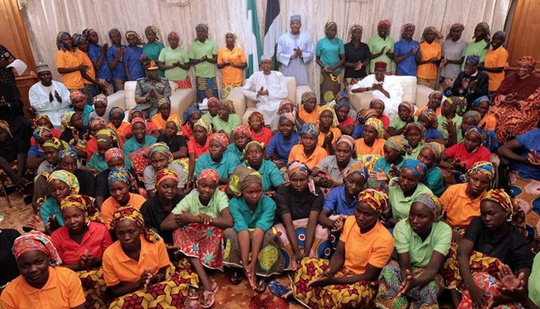Abuja, May 8: Nigerians celebrated the release, on Saturday May 6, 2017, of 82 girls from Boko Haram militants. The girls' kidnapping in 2014, from the northeastern town of Chibok, made global headlines and launched the hashtag #BringBackOurGirls, which resonated with millions of people around the world, including former First Lady of the United States, Michelle Obama.

The girls were set free following negotiations between the government and Boko Haram, which, in exchange, received members of their group held by Nigerian authorities, according to a statement from the Office of the President.
In April 2014, 276 schoolgirls from a government secondary school in Chibok were abducted by Boko Haram, a group that, over a seven-year period, has waged a violent campaign against the Nigerian government, which has led to the death of thousands and the displacement of two million people. At the time, 57 of the children captured by the militants managed to escape. In October, a further 21 were set free. Yet, even after the release of this latest group, 113 Chibok girls, as they have come to be known, are still missing.
International voices weren't the only ones bringing global awareness to the kidnappings. Local activists, such as Dr. Obiageli “Oby” Ezekwesili and others, led protests from the very beginning, “demanding accelerated government action in the release” of the schoolgirls. And now, their work is finally bearing fruit.
On Saturday, the official government statement said negotiations with Boko Haram “yielded results”:
After lengthy negotiations, our security agencies have taken back these girls, in exchange for some Boko Haram suspects held by the authorities. The released #ChibokGirls are due to arrive in Abuja tomorrow Sunday May 7, and will be received by the President. President Muhammadu Buhari expresses his deep gratitude to all who played a part in ensuring the success of this operation, as follows: Security agencies, the military, the Government of Switzerland, the International Committee of the Red Cross, and local and international NGOs.
The International Committee of the Red Cross acted as intermediaries in the negotiations:
Acting as a neutral intermediary, we @ICRC transported 82 #ChibokGirls to the government of #Nigeria. pic.twitter.com/FTiAnjXejq
— ICRC Africa (@ICRC_Africa) May 7, 2017
Journalist Stephanie Busari commended Dr. Ezekwesili and her group for their “resilience and steadfastness” in their fight to secure freedom for the abducted schoolgirls:
Aisha Yesufu, a collaborator of Dr. Ezekwesili's in the Bring Back Our Girls Group, tweeted:
Other Twitter users were agog at the news:
Despite the good news, some folks on social media remain unimpressed by the actions of successive governments over their response to the incident. Ikhide, a literary critic, decried the “zero transparency in the whole process” on Facebook:
…On Chibok, our government has refused to talk to us. All legitimate questions have been dismissed and any thinking person who dares ask questions is demonized as a Chibok denier. What happened in Chibok? Our government will not tell us. Because no one will hold them accountable. Can you imagine this happening anywhere else in the world? How can you do this to your own people?
Why should people believe the Chibok narrative when there is zero transparency in the whole process. No one truly knows what happened and the government is invested in lying and obfuscation. Can you imagine this happening in the U.K.? I have so many questions about this Chibok mess; each one has been ignored. This government expects no questions but demands respect and blind obedience. Why have they not released the girls that were ‘released' the last time to their parents? That was months ago? What kind of country is this????
Ikhide may be alluding to what happened to the group freed in October, who were initially kept in government custody. At the time, a minister said this was because “a team of medical doctors, psychologists, social workers, trauma experts” were going to examine them. “Especially because they have been in captivity for so long,” the minister said. “We are now contacting their parents as part of the necessary verification exercise.”
In December, however, they were reunited with their families for Christmas. There were reports that some of the girls “were kept in a politician's house and barred from going home,” according to the BBC. Nevertheless, they returned to school in January to “sit for their final exams“.
As for the latest freed girls, Amnesty International has urged the Nigerian government to respect their privacy. Osai Ojigho, country director of Amnesty International in Nigeria, said:
“It is vital now that they receive adequate physical and psychosocial counselling and support so that they can fully reintegrate in their communities…The government should also respect their privacy and ensure that the released girls are reunited with their families and not kept in lengthy detention and security screening which can only add to their suffering and plight.





Comments
Add new comment